Oct. 8
Meeting program to feature
botanical watercolor techniques
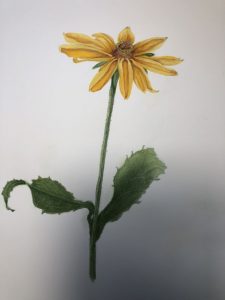
by Suzanne E. Thorin
Scroll down to Painting Composite Flowers to learn more about botanical watercolors.
Suzanne Thorin will present a one-hour program providing a brief background of botanical art, examples of outstanding botanical artists, information about the major professional association, and some tips for painting botanicals. During the second half of the hour, members will draw a leaf on tracing paper, transfer it to watercolor paper, create a tonal shading, plan colors, and apply the first color washes.
Suzanne’s program will follow a brief business meeting that starts promptly at 6 p.m. at the First Christian Church, on the corner of Washington Street and Kirkwood Avenue. Please remember the group is working with a new schedule of business meeting at 6 p.m., refreshments at 6:45, and program at 7 p.m.
- Supply list for Suzanne’s program
- iPad or iPhone (to photograph leaf)
- watercolor paper (Arches block, 11 X 14, 140# or your favorite hot-press paper. I will have Arches hot-press paper for anyone who needs it.)
- tracing paper (9 X 12, Canson Vidalon Translucent vellum is best, but bring what you have in your arsenal)
- pencil (Staedler Mars Lumograph 100. HB is fine.)
- pencil sharpener
- erasers (kneaded rubber and, if you have one, a Tombo Mono Zero or other small eraser)
- paint brushes (Winsor & Newton, Series 7, sable, #1, #3, #4 — or any of these numbers and the brand you have. Also if you have an eradicator brush, bring it.)
- watercolors (Bring a variety, including some greens — sap, leaf, Hooker’s, etc. — plus ultramarine blue, burnt sienna, burnt umber, permanent magenta, lemon yellow, etc. Bring whatever you have in your palette that you love.)
- 2 small jars for water
- magnifying glass
- white board (if you use one)
- divider (a measuring tool, similar to a compass but with 2 points; if you don’t have one, Suzanne will have one to share.)
- Suzanne will provide leaves, but you may bring your own as well.
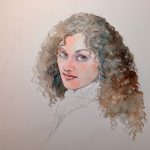
Amira
by Deborah Rush
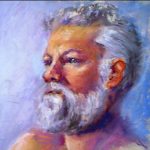
Brian
by Sande Nitti
Portrait Group to show work
The Bloomington Watercolor Society’s Portrait Group will stage an exhibition at the Monroe County Public Library gallery from Oct. 5 – 31. More than 50 works in a variety of mediums will display the faces and figures of a diverse range of models. Opening reception is Oct. 5 from 4:30 – 5:50 p.m. in conjunction with First Friday Gallery Walk.
Oct. 13
May Creek Farm site of final 2018 Saturday paint-out
Enjoy a Saturday paint-out and potluck lunch with your BWS paint pals at May Creek Farm Oct. 13 from 10 a.m. to 2 p.m. In addition to your painting supplies, bring a covered dish to share and your own plate and utensils. The shelter has electrical outlets that can accommodate a few crockpots.
The address is 8755 S Rockport Road, Bloomington IN 47403. Sara Steffey McQueen, a May Creek resident, says GPS sometimes sends people past their place so be alert. Here are suggested directions:
From Bloomington, take either Second Street or Third Street west to S.R. 37 South. Stay right to avoid getting on I-69. Turn right (west) at the first stoplight, which will be at Victor Pike. Follow Victor Pike and stay right as it splits at a “bottom.” Go up a large hill with a quarry. At Rockport Road ( a T intersection), turn left. May Creek is about a mile.
“Our community has a pinetree-lined drive to the left with a tall sign that has about 10 addresses and our name at the top,” Sara says. “Take the gravel drive and you will pass our dumpster, mailboxes, and come to the parking lot. Usually you will see a large white ‘Farm truck’ parked there. Park in the lot, and as you get out, walk to where the gravel leads — to the grassy field. We are painting wherever you are drawn. As you walk to the end of the gravel, look toward the Maypole and volleyball net. Walk across the field, between the Maypole and volleyball net, through the orchard, and you will see the shelter house with a blue metal roof. This is where we have an outhouse, running water, picnic tables, electricity, and a sweet little pond. We will have lunch there.”
Outreach
BWS member teaches color mixing
at Academy of Science and Entrepreneurship
by Cassidy Young
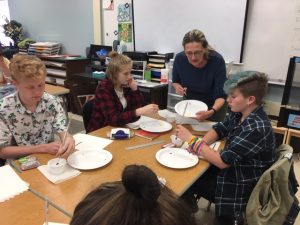
Nancy Metz worked with the art club at Academy of Science and Entrepreneurship.
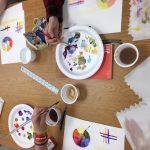
Nancy Metz presented a watercolor mixing tutorial to the high school art club at the Academy of Science and Entrepreneurship last month. Around a dozen students explored mixing and glazing watercolor paint. The presentation was an excerpt from Nancy’s beginning watercolor class she has taught through Ivy Tech’s Center for Lifelong Learning.
Thanks to donations made to The Teachers Warehouse and the materials for the arts (local free supply facilities for teachers), each student left with not just new painting experience and some color theory but also their own uniquely created personal travel palette made from Altoid tins, sponges, and watercolor cake containers.
Editor’s note: This was a highlight of September for me. If you are interested in sharing any of your artistic skills to a polite and fairly avid group of high school students, talk to Cassidy. In October the art club will be working in ink, and in November fiber arts. –N.M.
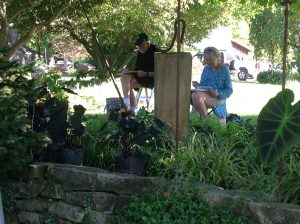
Jerry Harste and Carla Hedges working at a Tuesday paint-out last month at the home of Karen Pacific and Dave Shipley.
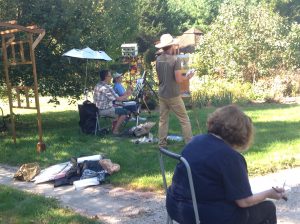
A September Tuesday attracted several Upland painters to the home of Karen Pacific and Dave Shipley.
Upland fall schedule features
great destinations, next planning meeting
Come paint with Upland this fall at some super destinations on private property in October. November brings us inside with a paint-in at the Brown County Gallery and an organizational meeting. Then we will break until mid-January. Winter 2019 will feature indoor destinations to keep us inspired.
Upland will meet Nov. 13 to start planning for 2019. The earlier date will help avoid the winter weather issues that have plagued January planning meetings . Come learn about all things Upland and enjoy the lunch pitch-in social. Be thinking of where you would like to paint and when you can host. Please email agenda items to Kristen.
Oct. 9 Eric’s Horse Farm, hosted by Eric Brock (long distance)
Oct. 16 Gnaw Bone Camp, hosted by Jane Matranga
Oct. 23 Nashville, hosted by Lory Winford
Oct. 30 Laura Lynne’s Place, hosted by Babette Ballinger
Nov. 6 Brown County Paint-in, hosted by Jacki Frey
Nov. 13 Planning Meeting at Sherwood Green Clubhouse, hosted by Kristen Stamper and Betty Wagoner
Art of Chocolate news
BWS to exhibit “We Paint … the Blues!“
BWS will again participate in the Week of Chocolate with an exhibit at the Vault. LIFEDesigns will continue the ever popular theme of Mardi Gras. Our theme for the exhibit?
We Paint … the Blues!
Why? The blues grew up in the Mississippi Delta just upriver from New Orleans, the birthplace of jazz.
As a heads up, LIFEDesigns will be looking for work that can be used on marketing materials. If you get an early start and wish to submit your image for possible use on the invitations, the programs, other promotional materials, please do so preferably within the next three to four weeks. LIFEDesigns will make the final choice. Please let Jeanne Dutton know if you are interested and inspired — blues@bloomingtonwatercolor.org
The prospectus for We Paint … the Blues! will be posted by the October meeting and formally announced then.
Painting composite flowers
by Suzanne E. Thorin
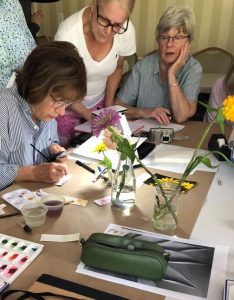
Catherine Watters demonstrating her botanical watercolor techniques.
The Friends of Wellesley College (Wellesley MA) offers a certificate program in botanical art and uses the resources of its large botanical garden and an excellent teaching staff and visiting instructors.
Having been in the certificate program before I moved back to Bloomington, I was able to enroll in a three-day course this summer, “Painting Composite Flowers,” taught by Catherine M. Watters, who is a well-known botanical artist and also a fabulous teacher and mentor.
Composite flowers include asters, cosmos, dahlias, daisies, sunflowers, zinnias, and many others. Each flower is made of many little flowers (florets) that sit on a platform (receptacle) and the center or disk is made up of little tubular florets. The centers of composite flowers are notoriously hard to paint! One can see circular patterns, which are actually Fibonacci numbers. Fibonacci patterns occur in nature in petals, seed heads, artichokes, and leaf arrangements. The patterns fill space efficiently and expose the plant to proper amounts of sun and water.
Catherine had provided us with a complete list of supplies, including paints, paper, tools (even lamps and magnifying lamps) and brushes, so we arrived ready to paint. I remembered to check my suitcase to Boston so that the tubes of paint would not be confiscated ($25 extra, of course).
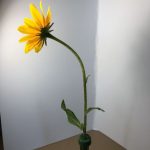
The flower Suzanne painted
Day One: We selected our flower from a huge bouquet supplied by Wellesley, planned our composition, photographed the flower for shape and shadow, drew a detailed pencil drawing on tracing paper, and added tonal shading. Throughout the day, Catherine walked around to each of us and made suggestions. She also gave 5- to 10-minute demonstrations. At the end of class we put our live flowers in the refrigerator and hoped they would live another day.
Day Two: My flower was in total distress the next morning, and I had to revive it by bathing it in cool water for 15 minutes (Catherine’s suggestion). It perked up and lasted two more days. We carefully studied our flower and leaves and used tester strips to make sure we were on target with colors. Some of us were painting daisies, and it was so interesting to compare the W&N and Daniel Smith New Gamboge. The pigment numbers on the tubes tell the story. My flower was a definite Daniel Smith New Gamboge. Catherine calls the first coat of paint a Tea Wash because it is so watery and the color faint. By the end of Day 2, most of us had applied a number of layers of paint.
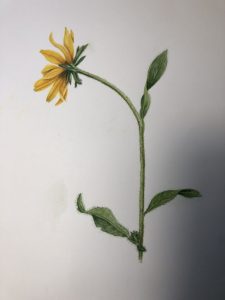
A nearly finished painting
Day Three: Gone was my thought that we wouldn’t have enough to do. We added an hour to the final day and painted throughout except for our 20-minute lunch, which we brought with us. By the end of the day, when we posted our work for Catherine’s comments, I was surprised that I had gotten as far as I had. Others were behind me, but a few talented souls had almost completed their paintings. I had one nasty leaf that didn’t look right to Catherine. She corrected the turn of the leaf and showed me how to remove green paint from my hot-pressed paper. She uses a Mr. Clean sponge and cuts a small piece, wets it, and uses a tool that grabs the little wad and aids her in excising the unwanted color.
I learned so much in this class and renewed old friendships with some of my colleagues. The course cost nearly $350 plus my airfare. I was lucky to have been invited to stay with a fellow painter in Brookline so I didn’t have hotel expenses. It was worth the price, and I am ready to return for another class with Catherine next August.
Member News
Betty Wagoner, Jacki Frey, Anne-Karine Bley, and Katya Alexeeva attended the Indiana Plein Air Paintout Weekend at Michigan City September 21 – 23.
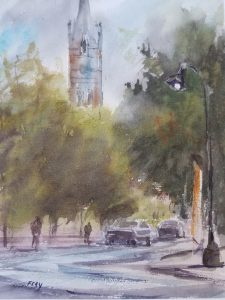
Franklin Street
by Jacki Frey
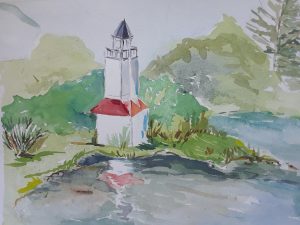
Botanical Garden Lighthouse
by Betty Wagoner
Beyond BWS
The Friends of T.C. Steele Member Art Show is Nov. 1 – 29. It is open to all Friends members. The show will be in the new T.C. Steele Visitor Center. If you are not a member, you may join when you register. The entry form, guidelines and information are at http://www.tcsteele.org/. Show entry forms are due Oct. 21; artwork is to be dropped off Oct. 30-31. The Reception and Friends Annual Meeting and Studio Wagon Celebration is Sunday, Nov. 4, from 2 – 4 p.m. You can call 812-988-0566 with questions.
IMO
Social media users recognize IMO as an abbreviation for “In My Opinion,” and each month we close by giving you the chance to share your opinion on a specific question.
This month the question is:
What makes a person an artist? How do you know when you have earned the right to claim the august title?
Kitty Garlock
When I was a student in elementary education this same question was asked of writers … when is a person a writer? I came to the conclusion then and I guess I still hold to it, that once you have started doing whatever it is, writing, painting, sculpting, reading, skiing, etc., you can claim to be a person of that skill. An artist is anyone who has begun to create no matter where in that journey they are!
Claude Cookman
In the early 1990s, a world-renowned photographer, referring to his renewed interest in drawing, told me that nobody in the Paris art world would take you seriously unless you sold your work. At first that seemed an overly simplistic stricture which unfairly privileged professional artists over amateurs, and I still don’t like excluding amateurs. On reflection, however, I understand it is the professionals who go into their studios every day and work eight to 12 hours who actually achieve high levels of art through the 10,000 hours of practice that Malcolm Gladwell articulated in “Outliers: The Story of Success.”
Meri Reinhold
My answer: courage. You don’t have to be a master or “talented.” You don’t have to have desire, the drive to create, to let your soul grow.
I love a quote by Kurt Vonnegut: “If you want to really hurt your parents, and you don’t have the nerve to be gay, the least you can do is go into the arts. I’m not kidding. The arts are not a way to make a living. They are a very human way of making life more bearable. Practicing an art, no matter how well or badly, is a way to make your soul grow, for heaven’s sake. Sing in the shower. Dance to the radio. Tell stories. Write a poem to a friend, even a lousy poem. Do it as well as you possibly can. You will get an enormous reward. You will have created something.
Question for November:
How do you know when a painting is finished?
Send your 1- to 3-sentence response to Nancy Davis-Metz by Oct. 21, and look for your opinion in the November issue. Please use IMO as your email’s subject line.